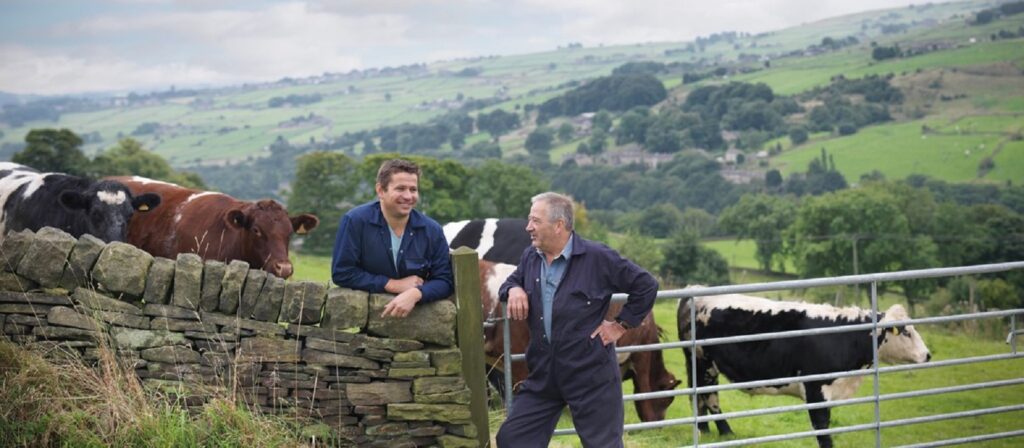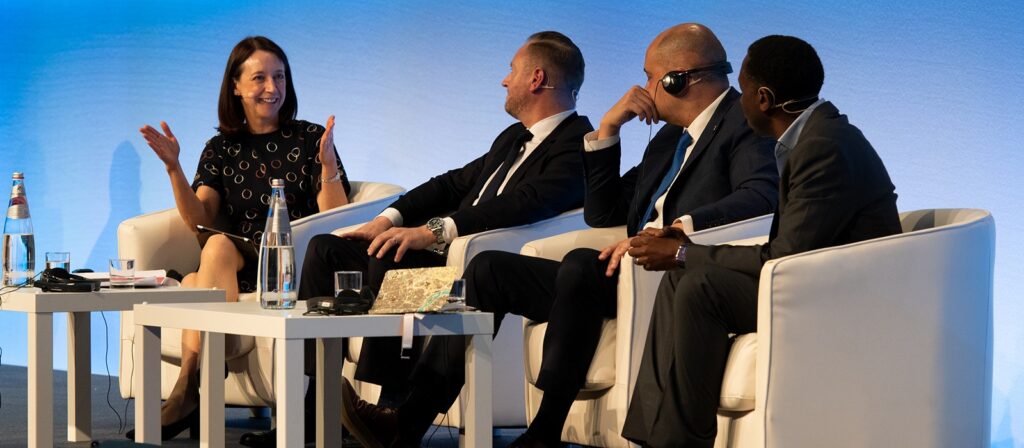Piers Watson:
Thank you very much. And yeah, it is really exciting to have this series hopefully of seminars focused on customer experience. I know that, as all of us as practitioners, we know we are fighting our cause within our organisations around the need for brilliant customer experience as a key differentiator. And across other industries as well, customer experience is set now as one of those exec level discussion and debate points around where an organisation needs to focus. So hopefully this will be a series of events that we’ll all participate and get value from.
So myself, head of customer experience, I’ve joined from various insurance companies in my past. And then Andrew, who is our experience design manager, and he’ll be talking you through the main part of the presentation.
But first, just a little bit of background on us. I won’t go through each bullet point. But essentially, we are a rural insurer, our core base really is our rural communities, our farming base essentially. As you can see, we were started by seven farmers.
But what’s unique also about us is that within the UK, we are the only real insurance firm that has a tied agency network. We have around 290 offices around the country. And they are really the face of our brand. They’re the ones that are dealing with the majority of our customer base day in day out. And we have a very local personable type of experience for our customers.
We do predominantly general insurance, that will be farm, commercial, personal lines, classic motor and home, equine, all of those things. We also do financial services as well, so we distribute our products through our financial advisors.
And then we also have what we call risk management services, which is effectively going out and advising our clients, particularly farm-based and commercial-based, on health and safety, the risk aspects. And we are evolving that more and more into prevention-based solutions as well. So that’s us in a nutshell.
And a little bit about history of customer experience, and I use this metaphor, this image really, I used it at our exco recently for where I think we’ve got to and where we’re going. But also I think it really can relate to when I first joined NFU Mutual. And maybe you’ll recognise this, as a CX lead, I wanted something to go at. And when we did our first benchmarking survey, I was a little bit disappointed actually that NFU Mutual were number one, we were top of the tree, top of the mountain if you like, on customer experience performance when compared with our competitor base.
But I should have known that already because when I talked to ex-colleagues who are customers, they all said, yeah, how much they loved NFU Mutual. So when I spoke to our then to be CEO, I said, “Well, what’s my role? What am I here for if already we’re at peak?” And his response was, “You need to keep it that way.”
Of course we’re in the middle of Covid at that time, as all of you were, but since then we’ve obviously had cost of living challenges, we’ve had competitors really focusing more and more on customer experience. But also internally, we’ve been through lots of transformation. We’re going through that now with changing our policy admin system, we’re moving to more digital channels, although that’s not our primary channel. We’re looking at our telephony systems, we’re looking at how we evolve our agency network. So there’s a huge amount of change.
And with external pressures and internal pressures, just keeping customer experience at that level is a real challenge and an opportunity for us. Where you see that peak in the distance is that I think actually we have achieved a number of things, and looking at that peak, I’ll probably say we’re now at that halfway up that next mountain. But we absolutely have come across challenges and opportunities as well, and we still do.
Now, if you look at that Venn diagram, there are three elements to that. The CX-led change, and we’ll be talking about this in the heart of this presentation, is how do we make sure that we’re designing for customer experience in the future? So when we’re looking at new change, making sure we’ve set out what good looks like, and embedding that into our change mechanisms. So we’re still working on that, we’re embedding it into different cycles, but we’ll talk about the role of our Customer Experience Blueprint.
On the customer insight side, that’s about how do we listen to our customers. And when I joined, we had very patchy voice of customer. We only had it for a few journeys. We’ve now got it for all journeys. We only recently have consolidated that onto one platform. So we’re getting more sophisticated at being able to understand our customers in the moment on top of classic customer research, et cetera.
And then finally, on the governance side, we hadn’t really a shared sense of collective responsibility around the customer. We had no shared customer experience measures in our metrics. So we’ve now got those. And we also have, with that CX benchmarking, we have that metric in our bonus. So now everyone is rewarded on customer experience performance. So we’ve done a lot to strengthen governance, but we’ve still got a way to go.
Andrew Weiner:
Hi, everyone. I’m going to talk a little bit around our CX Blueprint. So Piers touched on a little bit the story that we’ve been on for customer experience at NFU Mutual. And the Blueprint is quite a big moment for us in terms of, I guess, really giving us a tool to certainly support our ambitions and the business’s ambitions when it comes to CX.
So I want to take you for a little bit of a journey for where we’ve been, a little bit of rationale for why we’ve done it and where we are now. So just to go back to the beginning, where we found ourselves was, there were different views across the business depending on the area around what it meant to dominate in customer experience, which was a key strategic goal for us as NFU Mutual. We didn’t have this single universal view of actually what that target state experience was. We had some pockets of that, whether it was product specific or customer specific, but nothing at this universal level.
We did have a high level CX vision, which talked about things like showing care and consideration for instance. And we did have some really low level requirements as well, which we’ve been feeding into various projects. But we didn’t really have this piece in between which could be fed into any area and gives them something to grab hold of.
And I think really, we’re a small team, I’ve got a team of round four, and yeah, we can’t be everywhere all at once. So really thinking about how can we empower our people to be thinking about customer and decisions they’re making. So that’s where we were.
It leads me on to goals and benefits for this. So we wanted to set out this ‘north star’ for customer experience across the business and what it really means when we talk about dominating customer experience. We wanted to consolidate a view of all of the journeys, and we’ve done multiple journey mapping pieces of what we’re looking at, target states, so provide that consolidated view. We wanted to visualise this in a way which people could really grab hold of. And ultimately, I think quite key is we want to make a toolkit for the business. To that point around we can’t be everywhere, we want something that people can use and can be confident that they’re working to the right goal and they’ve got the tools there to allow them to do that. So that’s a little bit around goals and benefits.
In terms of the process of building this, I just wanted to share a little bit of the train of thought, and I’ve popped a few supporting questions which we were asking ourselves at each of these stages. So I think the first one was actually what that framework is. So when we look at our end-to-end customer journey, how do we break that down? What are the key stages and steps within that? We wanted to get the right level of detail in there, where this is useful, is a strategic document. But equally it can’t give you everything. It can’t go into the real detail of very specific micro journeys.
We wanted to leverage some of the existing work, be that from a CX perspective, some of the customer research that we’ve got, which talks to a little bit of that customer need, where are those expectations, gives us a sense of actually what that aspiration should be. So we did want to leverage that.
It’s really important for us that this is all about co-creation, so it can’t just be a CX thing that we are doing in our own team, actively working with some of those key stakeholders. Who ultimately will be using this and be important for embedding it. That was key.
So we went through, ourselves, a number of sessions with different areas just to understand their input and how does this work for them ultimately. How do we land it in a way which is going to deliver value to them? So that was a really important stage. And we spent a good amount of time actually engaging in iterating out a number of the layers that we’ve got in there.
Next we had testing with customers. So we are fortunate that we’ve got an internal forum of customers, I think around 3000 or so who we’ve got access to. So what we did want to do was share particularly some of these promises that we were thinking about in terms of target state and say, “Actually does that meet our customers’ needs and expectations?”
And quite interesting to understand, one, the relevance of those. So is it the right one? But also the relative importance. So are some outcomes or promises more important than others? So just giving that sense, which would then be useful for conversations later down the line was another critical step.
We’re always thinking about use cases, so where is there energy in the business to really take this? As said, we’re there with this strategic document, but we need people in the business to buy into it and look at how they can use it. So really thinking about where those opportunities are, be it within your change teams for instance. I’ll come on later to an example we have with our contact centre for instance, which we’ve done some really cool stuff with off the back of this. So that was something just to consider particularly when we were wanting to land this. Which was quite a new thing, certainly for us as a business, having some good early use cases was really important.
And to that theme as well, how we communicate, so the internal communication strategy, the launch of it itself and that ongoing communication is something we think a lot about. And is something that’s quite a big focus at the moment a year or so after we launched this, where we’re really just wanting to make it very visible to the organisation, that this is there as a tool to be used.
So hope it gives you a bit of a sense of the process we went on. Just to give you a sense of, yeah, when we talk about our Blueprint, what it is. So I spoke a bit around framework. We have four stages in our mind to our customer journey. So along the top. Getting covered, which is your quote stage. Managing the policy, so making changes, renewals, general queries. Getting on with life, is this value add piece, so outside of just the core insurance products and services, that’s certainly a space which we’re quite interested in, how we can play more in. And then dealing with a problem, which is there at the end, is our claims experience and complaints as well. So we broke our experience into four stages.
Within each of those then, I guess, we start to dive into some more detail around what is that future state alongside that. A big part was just around customer emotions. So Piers mentioned earlier voice of customer. So that feedback that we’re getting directly from customers, which is more emotive in nature. So I think our ideal state is that we have this dynamic view of customer feedback at each of these stages of the journey, which talks to some of those emotions that customers are going through, both positive and negative.
We then translate that down into some steps. So getting covered as an example, there’s a few high-level steps that the customer goes through. And each of those, there are going to be some goals that the customer has. And equally there are going to be some business goals as well. And the ones we’ve got there are illustrative. But I think the key consideration for us there was that when we’re thinking about that target state, we need something which, one, delivers the customer goals and also the business goals. So it can’t just be really focused on that customer side. And we also know there’s going to be a few points where those two things can clash as well. And that leads to some interesting discussions which we highlight.
The real key part of this is what we call our service promises, which is where we have a lot of detail, and it’s purposely detailed. That was, I guess, a reaction to the use that we wanted to have. So particularly thinking about change, these are effectively the outcomes that we are seeking to deliver. So will be directly fed into our change programmes. And we will ultimately want to measure the delivery of each of these outcomes.
But really this is around translating our high-level vision, so I mentioned things like care and consideration, down into very specific journey stage. So how we show care and consideration at point of quote could be quite different versus first notification loss in claims. So just taking it down to a journey specific level, which gives our people enough detail to be anchored in. But these are still agnostic of any particular product or channel. So there is ultimately another layer down from this. But this is all around just showing that connection back up to customer and having something which is a reference point.
So I won’t go into any more detail on the Blueprint, I just wanted to give a little bit of a visual view of what we’re talking about when we say the CX Blueprint. So I’ll just hop back in now to the presentation.
The service promises, as I said, there’s a lot of detail there. I mentioned our customer research earlier on. When we did that, there were five key themes, just to give you an idea of the type of content in there, that came out. So it was all around, from a customer’s perspective, taking prompt action. So yeah, as I said, there were these five themes that really underpinned all of these promises that we wanted to make to customers. So taking prompt action, making things as easy as possible for our customers. On my terms is things like channel, so accessibility and just making sure we can be there where our customers want us. Help me understand is around that real simple communication, making it really clear what are the next steps, what’s the expectations when we’re going into some of these processes. And taking the lead is a bit more around proactivity, customers don’t chase us, we’re always on the front foot. So that was a key part. And just this is quite a nice high-level summary I think of ultimately the ambition that we want to deliver.
So I can jump onto the next slide please. So a bit around how we’re now using this. So I’ve mentioned the change piece, which is definitely an important one, both at a strategic level, so as an organisation we’re going through quite a lot of big transformational change at the moment. So this is definitely a key input into that. But equally there’s loads of local change that is happening. So having something that is there as a consistent ‘north star’, it is something that’s really valuable to us. It just makes sure that everyone is aligned in terms of the objectives that we’re looking to deliver. So the change piece is a real fundamental reason why we’ve rolled this out.
For my team, in terms of some of the design work we do, this is a framework we keep coming back to, be it just the language and the stages that we use. So we’re always using that same common language. We’ve seen some really nice examples of how it’s driven a slightly different conversation. So particularly in operational areas where, I’m sure you’ll have this, where there are targets around efficiency or speed for instance, and they appear as green. We’ve been using this to push some of our colleagues, in actively doing that themselves, to say, “Actually even if that is green, is it the right target, how do we push ourselves even further?” Particularly with that goal around dominating customer experience. So it’s been great to see how people have started to really use this as a conversation starter if nothing else.
And the final thing is thinking about our voice of customer and pain points. And again, a common goal, common framework, about how we can align some of those pain points. Which starts us on this piece of being able to measure where we are today versus where we want to get to ultimately.
An example I just want to draw out was Mutual Direct, which is our contact centre. So they were one of these early use cases that we identified. And you can see, quite small, but we did a whole launch event there. We made quite a lot of noise about this. But they were then actively looking at how do we translate that into something that frontline teams can use? So things like customer charters. It ended up going into training modules as well. So how we really place customer goals, outcomes at the heart of what we do? Improvement ideas as well. So there’s been a real good set of activity, which is still going a year later at the moment in that area. Which is a really good example of how you can take something which is quite strategic and then translate it into something which certainly from our frontline teams they can connect into.
If I just jump onto the final slide then. So yeah, I think where we are now is probably we’ve laid some the foundations. We’ve got a number of parts, the Blueprint is one, we’ve talked a bit around voice of customer as well. So the foundations are there. I think there’s a long way for us to go in terms of really embedding all of this and getting us to this point where we can say we’re truly customer-centric in how we operate.
A big part is measurement. So how we can measure and track the delivery of that experience today. Which voice of customer is going to be a huge part of. But equally understanding how our operational metrics link into customer experience outcomes is another interesting area. And where there is a specific connection, we are looking into that space as well. Internal communications, there’s a big focus for us as a team at the moment in terms of just making a lot of noise around customer experience as a whole. And we’ve got an event coming up in a few weeks time, we’ll be launching voice of customer. So that needs to just be continuous. We’ve got more and more use cases which we want to start embedding this into, just to really cement it as something that is there to be used.
And the final point I just wanted to call out is saying, this will evolve, it’s not a static document. It is something which as our customers’ needs and expectations change, and that’s something we pull out from research and insights, we will need to evolve our view of what that target state is. And that’s particularly with that goal of wanting to stay at the top, as Piers said, to keep dominating. We need to stay alive to that. So that’s something we’ll be continuing to look at.
But yeah, that was everything I was going to run through, a pretty speedy run through of quite a lot of work. But hopefully gives you a bit of a sense of certainly the journey we’ve been on.
The above text has been produced by machine transcription from the webinar recording. ICMIF has made every effort to ensure that transcriptions are as accurate as possible, however, in some cases some text may be incomplete or inaccurate due to inaudible passages or transcription errors. Listening to or watching the webinar recording will allow you to hear the full text as delivered during the webinar but this is available in English only. Our transcriptions are provided to enable members to select the language of their choosing using the dropdown menu above.





